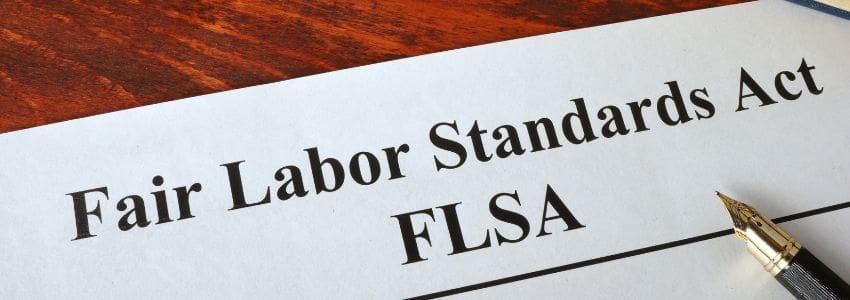Fair Labor Standards Act (FLSA) – Update Notice
Last Updated on May 28, 2024 / HR Compliance

HR Question:
What is the final rule by the Department of Labor to the Fair Labor Standards Act (FLSA) regarding overtime pay?
HR Answer:
The Department of Labor (DOL) recently announced critical updates to the Fair Labor Standards Act (FLSA) restoring and extending overtime protections. This is a final rule by the DOL, making an estimated 4.3 million American workers newly eligible for overtime pay. The last FLSA update to the salary exemption threshold took place in 2020 when the DOL set the salary threshold to $684 per week (or $35,568 annually), where it stands currently.
What is the newest FLSA change?
In summary, the FLSA final rule increases the salary level threshold for executive, administrative, and professional (EAP) employees, thereby leading to a significant increase in eligibility for overtime pay. Here are the highlights:
- Effective 7/1/24, the salary exemption threshold will rise to $43,888 annually (or $844 per week). The exemption threshold will continue to increase effective on 1/1/25 to $58,656 annually (or $1,128 per week).
- The DOL states that nondiscretionary bonuses and incentive payments can be used to satisfy up to 10% of the required salary level. Examples of non-discretionary bonuses could include attendance bonuses, individual or group production bonuses, bonuses for quality and accuracy of work, retention bonuses, and profitability bonuses.
- The new level for highly compensated employees will increase to $132,964 on 7/1/24 and $151,164 on 1/1/25. Currently, the threshold for Highly Compensated Employees stands at $107,432.
The DOL is also implementing automatic increases to the salary exemption threshold every three years. These automatic updates will begin on 7/1/27 and then increase every three years thereafter.
Want to hear more? Download our free on-demand webinar: “How To Navigate the Recent Regulatory Changes From FTC and DOL.”
What should we do now to prepare for the FLSA final rule?
Considering the upcoming July 1, 2024 effective date, employers should begin identifying impacted employees and work with their legal advisors to prepare plans to comply with the requirements. Some options may include increasing salaries to meet the new exemption threshold or transitioning those employees to non-exempt (and thus overtime-eligible) status.
Employers should also confirm that all exempt employees are performing exempt-level responsibilities. Employers can leverage job descriptions to ensure that the Fair Labor Standards Act “duties test” is met for each of their exempt-level roles, as that test has remained the same.
It could be beneficial to review any nondiscretionary bonuses employees may receive. Again, work with your legal advisors to ensure that the nondiscretionary bonuses total no more than 10% of the required salary level to help push them up over the threshold. If it does not take them over the threshold, consider your options, such as increasing their salary to meet the minimum threshold or transitioning them to hourly status where they would be eligible for overtime.
It is widely anticipated that there will be lawsuits filed in the coming weeks to challenge the DOL ruling. The results of the lawsuits may impact the rule itself or the effective date of the FLSA update.
To learn more, download our free on-demand webinar: “How To Navigate the Recent Regulatory Changes From FTC and DOL.”
Thank you to Christine McLaughlin for contributing to this edition of our HR Question of the Week!
Clark Schaefer Strategic HR knows that keeping abreast of HR compliance issues can be daunting, especially when the laws keep changing. We can help increase your chances of being compliant by offering resources to help you identify and mitigate compliance issues, such as our HR Audit which helps identify trouble spots in your HR function.




